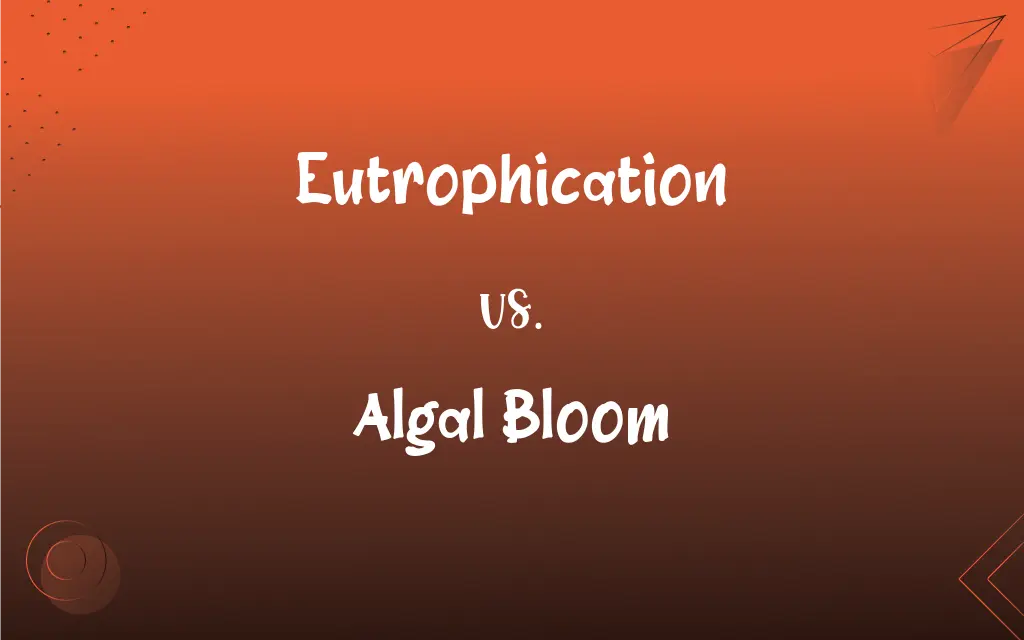Eutrophication vs. Algal Bloom: What's the Difference?
Edited by Aimie Carlson || By Harlon Moss || Published on February 16, 2024
Eutrophication is the nutrient enrichment of water bodies, often leading to excessive plant growth, while an algal bloom is a rapid increase in algae in water systems, frequently a result of eutrophication.

Key Differences
Eutrophication is a process where water bodies receive excess nutrients, primarily nitrogen and phosphorus, which stimulates excessive plant growth. An algal bloom, often a consequence of eutrophication, is a rapid increase in the population of algae in an aquatic system.
The primary causes of eutrophication are runoff from agriculture, wastewater, and industrial discharges rich in nutrients. In contrast, algal blooms are directly triggered by these nutrient surpluses, along with favorable conditions like sunlight and warm temperatures.
Eutrophication can lead to detrimental ecological effects, such as oxygen depletion in water bodies. Algal blooms, especially harmful ones, can produce toxins and further deplete oxygen, affecting aquatic life and water quality.
Preventing eutrophication involves managing nutrient inputs in watersheds. Managing algal blooms often requires addressing the root causes of eutrophication and can involve physical, chemical, or biological control methods.
Eutrophication is a broader environmental issue affecting lakes, rivers, and coastal areas, while algal blooms are a more specific event, noticeable by discoloration and scum on water surfaces.
ADVERTISEMENT
Comparison Chart
Definition
Nutrient enrichment of water bodies
Rapid increase in algae in aquatic systems
Primary Causes
Runoff from agriculture, wastewater, industrial discharges
Nutrient surpluses, sunlight, warm temperatures
Ecological Effects
Excessive plant growth, oxygen depletion
Production of toxins, further oxygen depletion
Prevention/Management
Managing nutrient inputs
Addressing eutrophication causes, various control methods
Visibility/Manifestation
Broad environmental issue
Specific event, visible as scum or discoloration
ADVERTISEMENT
Eutrophication and Algal Bloom Definitions
Eutrophication
Eutrophication is the enrichment of water with nutrients.
Eutrophication in the lake was caused by agricultural runoff.
Algal Bloom
It often results from nutrient-rich water.
Fertilizer runoff triggered a massive algal bloom in the bay.
Eutrophication
It leads to excessive plant and algae growth.
The pond's eutrophication resulted in thick algae mats.
Algal Bloom
Algal blooms can produce harmful toxins.
The recent algal bloom caused a fish kill due to released toxins.
Eutrophication
Eutrophication often results from human activities.
Industrial discharges have accelerated the eutrophication process in coastal waters.
Algal Bloom
Blooms can affect water quality and aquatic life.
The algal bloom has made the lake water unfit for recreational use.
Eutrophication
Eutrophication can lead to oxygen depletion in water.
The lake's eutrophication caused a significant drop in dissolved oxygen levels.
Algal Bloom
An algal bloom is a rapid increase in algae in water.
The algal bloom turned the lake's surface green.
Eutrophication
It can create ecological imbalances in aquatic systems.
Eutrophication has disturbed the aquatic life in the river.
Algal Bloom
Algal blooms are visible as scum on water surfaces.
A thick layer of scum from the algal bloom covered the pond's surface.
Eutrophication
Rich in mineral and organic nutrients that promote a proliferation of algae and aquatic plants, resulting in a reduction of dissolved oxygen. Used of a lake or pond.
Eutrophication
(biology) The process of becoming eutrophic; the ecosystem's response to the addition of artificial or natural nutrients, mainly phosphates, through detergents, fertilizers, or sewage, to an aquatic system.
FAQs
Can algal blooms be harmful?
Yes, some algal blooms produce toxins that can harm aquatic life and humans.
Can eutrophication be reversed?
Reversing eutrophication is challenging and involves reducing nutrient inputs and managing water quality.
What leads to eutrophication?
Eutrophication is primarily caused by nutrient runoff from agriculture, wastewater, and industrial activities.
What are the visible signs of an algal bloom?
Algal blooms often appear as green, blue-green, or red scum on the water surface.
How does eutrophication affect aquatic ecosystems?
It can lead to excessive plant growth, disrupting aquatic ecosystems and depleting oxygen levels.
Are all algal blooms toxic?
Not all algal blooms are toxic, but some can produce harmful toxins.
What ecosystems are most vulnerable to eutrophication?
Shallow lakes, slow-moving rivers, and estuaries are particularly vulnerable to eutrophication.
Is eutrophication a natural process?
While it can occur naturally, most modern eutrophication is accelerated by human activities.
How long can algal blooms last?
Algal blooms can last from a few days to several months, depending on conditions.
What human activities contribute to eutrophication?
Activities like over-fertilizing in agriculture, improper wastewater treatment, and industrial discharges contribute to eutrophication.
Can eutrophication occur in oceans?
Yes, eutrophication can occur in oceans, particularly in coastal areas with high nutrient runoff.
What measures can control algal blooms?
Controlling nutrient inputs and sometimes using algaecides can help manage algal blooms.
How do algal blooms affect human health?
Toxic algal blooms can contaminate drinking water and cause health issues if ingested or contacted.
What types of algae are involved in blooms?
Various types, including cyanobacteria (blue-green algae), are commonly involved in blooms.
Can algal blooms affect fish populations?
Yes, algal blooms can deplete oxygen and release toxins, adversely affecting fish populations.
Can algal blooms affect drinking water supplies?
Yes, toxic algal blooms can contaminate water supplies, making them unsafe for consumption.
What role do fertilizers play in eutrophication?
Excess use of fertilizers contributes to nutrient runoff, a key factor in eutrophication.
How does eutrophication impact biodiversity?
Eutrophication can reduce biodiversity by favoring certain species over others and disrupting food webs.
Are there ways to prevent eutrophication?
Prevention includes reducing nutrient runoff through better agricultural practices and wastewater treatment.
Does climate change impact eutrophication?
Yes, climate change can exacerbate eutrophication through increased rainfall and runoff.
About Author
Written by
Harlon MossHarlon is a seasoned quality moderator and accomplished content writer for Difference Wiki. An alumnus of the prestigious University of California, he earned his degree in Computer Science. Leveraging his academic background, Harlon brings a meticulous and informed perspective to his work, ensuring content accuracy and excellence.
Edited by
Aimie CarlsonAimie Carlson, holding a master's degree in English literature, is a fervent English language enthusiast. She lends her writing talents to Difference Wiki, a prominent website that specializes in comparisons, offering readers insightful analyses that both captivate and inform.































































